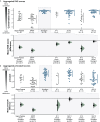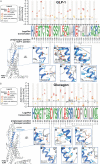Mutational Landscape of the Proglucagon-Derived Peptides
- PMID: 34220721
- PMCID: PMC8248487
- DOI: 10.3389/fendo.2021.698511
Mutational Landscape of the Proglucagon-Derived Peptides
Abstract
Strong efforts have been placed on understanding the physiological roles and therapeutic potential of the proglucagon peptide hormones including glucagon, GLP-1 and GLP-2. However, little is known about the extent and magnitude of variability in the amino acid composition of the proglucagon precursor and its mature peptides. Here, we identified 184 unique missense variants in the human proglucagon gene GCG obtained from exome and whole-genome sequencing of more than 450,000 individuals across diverse sub-populations. This provides an unprecedented source of population-wide genetic variation data on missense mutations and insights into the evolutionary constraint spectrum of proglucagon-derived peptides. We show that the stereotypical peptides glucagon, GLP-1 and GLP-2 display fewer evolutionary alterations and are more likely to be functionally affected by genetic variation compared to the rest of the gene products. Elucidating the spectrum of genetic variations and estimating the impact of how a peptide variant may influence human physiology and pathophysiology through changes in ligand binding and/or receptor signalling, are vital and serve as the first important step in understanding variability in glucose homeostasis, amino acid metabolism, intestinal epithelial growth, bone strength, appetite regulation, and other key physiological parameters controlled by these hormones.
Keywords: GCG; GLP-1; GLP-2; GPCR; glucagon; mutant; pharmacogenomics; proglucagon.
Copyright © 2021 Lindquist, Madsen, Bräuner-Osborne, Rosenkilde and Hauser.
Conflict of interest statement
The authors declare that the research was conducted in the absence of any commercial or financial relationships that could be construed as a potential conflict of interest.
Figures




Similar articles
-
Variation in the Evolution and Sequences of Proglucagon and the Receptors for Proglucagon-Derived Peptides in Mammals.Front Endocrinol (Lausanne). 2021 Jul 12;12:700066. doi: 10.3389/fendo.2021.700066. eCollection 2021. Front Endocrinol (Lausanne). 2021. PMID: 34322093 Free PMC article.
-
Two dipolar α-helices within hormone-encoding regions of proglucagon are sorting signals to the regulated secretory pathway.J Biol Chem. 2014 May 23;289(21):14968-80. doi: 10.1074/jbc.M114.563684. Epub 2014 Apr 11. J Biol Chem. 2014. PMID: 24727476 Free PMC article.
-
Identification of a proglucagon cDNA from Rana tigrina rugulosa that encodes two GLP-1s and that is alternatively spliced in a tissue-specific manner.Gen Comp Endocrinol. 2001 Nov;124(2):144-51. doi: 10.1006/gcen.2001.7697. Gen Comp Endocrinol. 2001. PMID: 11703080
-
Molecular evolution of proglucagon.Regul Pept. 2001 Apr 2;98(1-2):1-12. doi: 10.1016/s0167-0115(00)00232-9. Regul Pept. 2001. PMID: 11179772 Review.
-
Central pre-proglucagon derived peptides: opportunities for treatment of obesity.Curr Pharm Des. 2003;9(17):1373-82. doi: 10.2174/1381612033454775. Curr Pharm Des. 2003. PMID: 12769729 Review.
Cited by
-
The Location of Missense Variants in the Human GIP Gene Is Indicative for Natural Selection.Front Endocrinol (Lausanne). 2022 Jun 29;13:891586. doi: 10.3389/fendo.2022.891586. eCollection 2022. Front Endocrinol (Lausanne). 2022. PMID: 35846282 Free PMC article.
-
GLP-1 and GLP-2 Orchestrate Intestine Integrity, Gut Microbiota, and Immune System Crosstalk.Microorganisms. 2022 Oct 19;10(10):2061. doi: 10.3390/microorganisms10102061. Microorganisms. 2022. PMID: 36296337 Free PMC article. Review.
-
Role of Glucagon and Its Receptor in the Pathogenesis of Diabetes.Front Endocrinol (Lausanne). 2022 Jun 16;13:928016. doi: 10.3389/fendo.2022.928016. eCollection 2022. Front Endocrinol (Lausanne). 2022. PMID: 35784565 Free PMC article. Review.
-
Variation in the Evolution and Sequences of Proglucagon and the Receptors for Proglucagon-Derived Peptides in Mammals.Front Endocrinol (Lausanne). 2021 Jul 12;12:700066. doi: 10.3389/fendo.2021.700066. eCollection 2021. Front Endocrinol (Lausanne). 2021. PMID: 34322093 Free PMC article.
References
Publication types
MeSH terms
Substances
LinkOut - more resources
Full Text Sources

